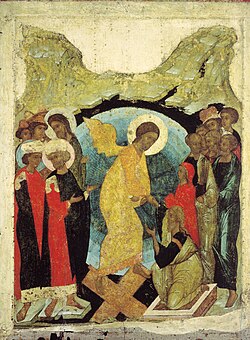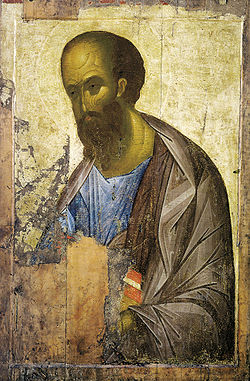Andrei Rublev
Russian artist (c. 1360 – c. 1430) From Wikipedia, the free encyclopedia
Andrei Rublev (Russian: Андрей Рублёв, romanized: Andrey Rublyov,[1] IPA: [ɐnˈdrʲej rʊˈblʲɵf] ⓘ; c. 1360 – c. 1430)[2][3] was a Russian artist considered to be one of the greatest medieval Russian painters of Orthodox Christian icons and frescoes. He is revered as a saint in the Eastern Orthodox Church, and his feast day is 29 January.[4]
Andrei Rublev | |
|---|---|
 Rublev on 1961 anniversary stamp | |
| Venerable Father (Prepodobne), Monk and Iconographer | |
| Born | c. 1360 |
| Died | c. 1430 (aged around 70) Andronikov Monastery, Moscow |
| Venerated in | Eastern Orthodox Church |
| Canonized | 6 June 1988, Trinity Lavra of St. Sergius by 1988 Local Council of the Russian Orthodox Church, |
| Feast | 29 January, 13 June, 4 July, 6 July, 22 August |
| Attributes | Clothed as an Orthodox monk, often shown holding an icon |

Early life
Little information survives about his life; even where he was born is unknown. He probably lived in the Trinity-St. Sergius Lavra, near Moscow, under Nikon of Radonezh, who became hegumen after the death of Sergius of Radonezh in 1392. The first mention of Rublev is in 1405, when he decorated icons and frescos for the Cathedral of the Annunciation of the Moscow Kremlin, in company with Theophanes the Greek and Prokhor of Gorodets. His name was the last of the list of masters, as the junior both by rank and by age. Theophanes was an important Byzantine master, who moved to Russia and is considered to have trained Rublev.
Career
Chronicles tell us that together with Daniel Chorny he painted the Dormition Cathedral, Vladimir in 1408 as well as the Trinity Cathedral in the Trinity Lavra of St. Sergius between 1425 and 1427. After Daniel's death, Andrei came to Moscow's Andronikov Monastery where he painted his last work, the frescoes of the Saviour Cathedral. He is also believed to have painted at least one of the miniatures in the Khitrovo Gospels.
The only work authenticated as entirely his is the icon of the Trinity (c. 1410), removed in 2023 from the Tretyakov Gallery, Moscow to the Cathedral of Christ the Saviour.[5] It is based on an earlier icon known as the "Hospitality of Abraham" (illustrating Genesis 18). Rublev removed the figures of Abraham and Sarah from the scene, and through a subtle use of composition and symbolism changed the subject to focus on the Mystery of the Trinity.
In Rublev's art two traditions are combined: the highest asceticism and the classic harmony of Byzantine mannerism. The characters of his paintings are always peaceful and calm. After some time his art came to be perceived as the ideal of Eastern Church painting and of Orthodox iconography.
Death and legacy
Summarize
Perspective
Rublev died at Andronikov Monastery between 1427 and 1430. Rublev's work influenced many artists including Dionisy. The Stoglavi Sobor (1551) promulgated Rublev's icon style as a model for church painting. Since 1959, the Andrei Rublev Museum at the Andronikov Monastery has displayed his and related art.
The Russian Orthodox Church canonized Rublev as a saint in 1988, celebrating his feast day on 29 January[6] and/or on 4 July.[6][7][8]
In 1966, Andrei Tarkovsky made a film Andrei Rublev, loosely based on the artist's life. This became the first (and perhaps only) film produced in the Soviet era to treat the artist as a world-historic figure and Christianity as an axiom of Russia's historical identity,[9] during a turbulent period in the history of Russia.
Historian Serge Aleksandrovich Zenkovsky wrote that the names of Andrei Rublev, Epiphanius the Wise, Sergius of Radonezh and Stephen of Perm "signify the Russian spiritual and cultural revival of the late fourteenth and early fifteenth centuries".[10] He also wrote: "The wonderful icons and frescoes of Andrey Rublev offered a harmonious and colorful expression of the spirit of complete serenity and humility. For the Russian people these icons became the finest achievement of religious art and the highest expression of Russian spirituality".[10]
Veneration
- 29 January – commemoration of his death anniversary (Greek Orthodox Church)[11][12]
- 12/13 June – feast day, Synaxis of All of Andronikov Monastery (with Andronicus, Sabbas, Alexander, Abbots of Moscow and Daniel the Black, the icon painter)[13]
- 4 July – main feast day from the list of "Russian saints of Moscow and Vladimir" by Nikodim (Kononov),
- 6 July – Synaxis of All Saints of Radonezh
- Synaxis of all saints of Moscow – movable holiday on the Sunday before 26 August (ROC)[14]
Selected works
- Baptism of Jesus, 1405 (Cathedral of the Annunciation, Moscow)
- Annunciation, 1405 (Cathedral of the Annunciation, Moscow)
- Version of the Theotokos of Vladimir, c. 1405
- St. Gabriel, 1408 (Dormition Cathedral, Vladimir)
- St. Andrew the First-called, 1408 (Dormition Cathedral, Vladimir)
- St. Gregory the Theologian, 1408 (Dormition Cathedral, Vladimir)
- Theotokos from Deësis, 1408 (Dormition Cathedral, Vladimir) Some think this may be the work of Theophanes the Greek
- St. John the Theologian, 1408 (Dormition Cathedral, Vladimir)
- St. John the Baptist, 1408 (Dormition Cathedral, Vladimir)
- The Saviour Enthroned in Glory, Christ in Majesty, 1408 (Dormition Cathedral, Vladimir)
- Harrowing of Hell, 1408–1410 (Vladimir)
- Ascension, 1408 (Tretyakov Gallery, Moscow)
- Apostle Paul, 1410s (Tretyakov Gallery, Moscow)
References
Sources
External links
Wikiwand - on
Seamless Wikipedia browsing. On steroids.
















